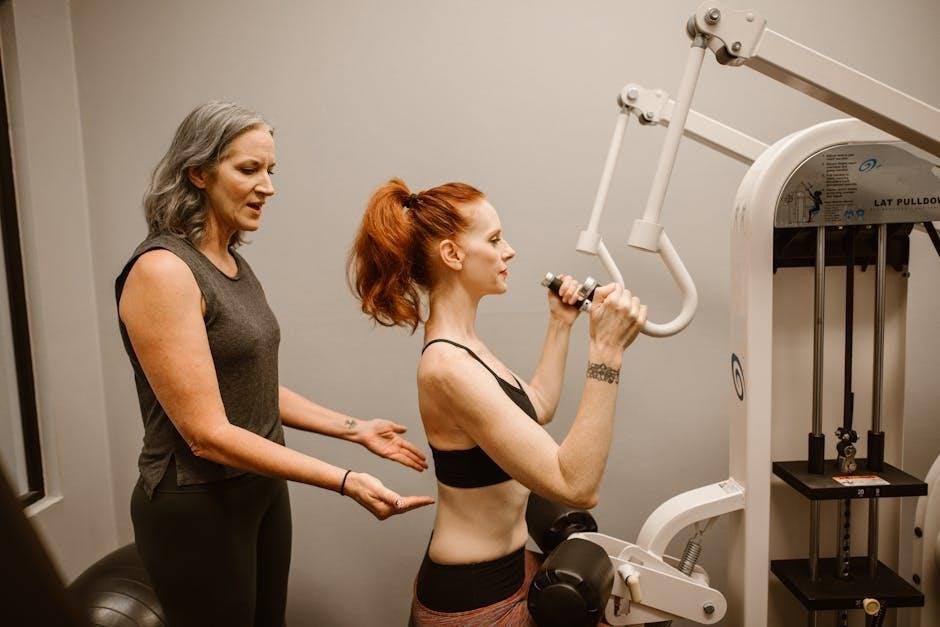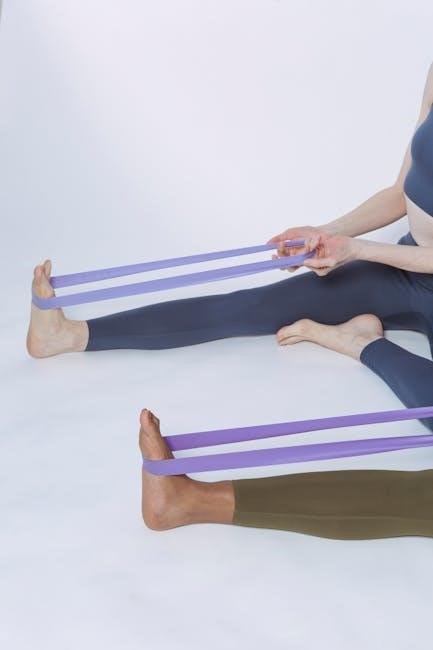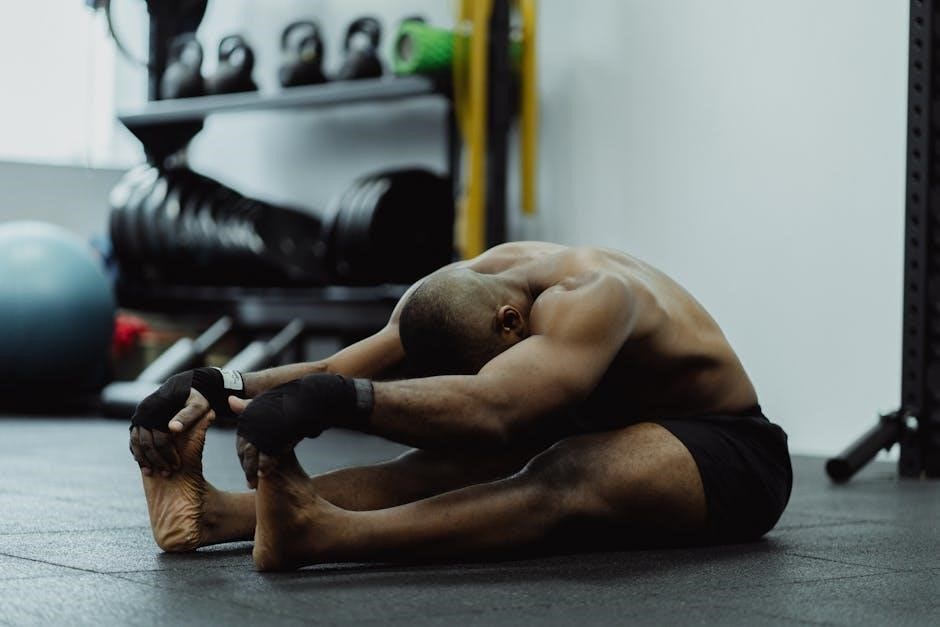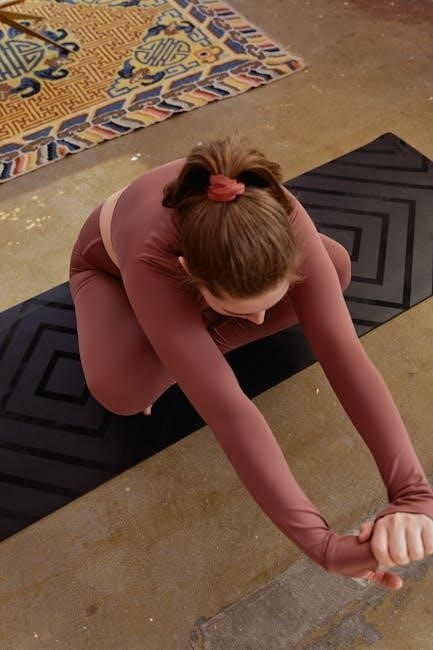Core exercises are essential for improving stability, posture, and overall athletic performance. Static and dynamic exercises target key muscle groups, enhancing functional strength. PDF guides offer structured routines, from beginner-friendly workouts to advanced programs, ensuring progression and injury prevention. Experts recommend combining compound movements with dedicated core drills for optimal results.
Importance of Core Strength
Your core is the foundation of your body, essential for balance, stability, and movement. Strengthening it improves posture, reduces injury risk, and enhances athletic performance. A strong core supports spinal alignment, preventing lower back pain and promoting better overall physical stability. Static exercises, like planks, and dynamic movements, such as twists, engage multiple muscle groups, boosting functional strength. Additionally, core strength is vital for everyday activities, aiding in lifting, bending, and maintaining proper body mechanics. Experts emphasize that a robust core enhances endurance and power, making it a cornerstone of any fitness routine. PDF guides from professionals like Dr. Michael Derry provide structured plans to achieve these benefits effectively.
Overview of Core Exercises PDF Resources
Core exercises PDF resources offer comprehensive guides for strengthening the core muscles. These downloadable guides provide detailed workout plans, including static and dynamic exercises, suitable for all fitness levels. Resources like Dr. Michael Derry’s guide feature 24 exercises with step-by-step instructions to build functional strength and reduce back pain. Fitness Ball Drills focus on stability and flexibility, while DAREBEE’s database offers a wide range of exercises targeting abs, obliques, and lower back muscles. These PDFs are designed to help users progress safely, with routines for beginners and advanced individuals. They often include visual aids and tips for proper form, making them invaluable tools for anyone aiming to improve core strength and overall fitness.

Anatomy of the Core
The core is a complex structure comprising major muscle groups, including abs, obliques, and lower back muscles. The deep core muscles, like the transverse abdominis, play a crucial role in stability and posture, forming the body’s innermost layer. Understanding this anatomy is essential for effective core training and injury prevention.
Major Muscle Groups in the Core
The core is a network of muscles that includes the rectus abdominis, obliques (both internal and external), and transverse abdominis. These muscles work together to provide stability and movement. The rectus abdominis is the visible “six-pack” muscle, while the obliques aid in rotational movements. The transverse abdominis, the deepest layer, acts as a natural brace for the spine. Additionally, muscles like the erector spinae and latissimus dorsi in the lower back contribute to core stability. Understanding these muscle groups is crucial for designing effective core workouts, as each plays a unique role in strength, flexibility, and posture.
The Role of the Deep Core Muscles
The deep core muscles, including the transverse abdominis, play a vital role in spinal stability and posture. Acting as an internal brace, they compress the abdominal contents and stabilize the pelvis during movement. Proper engagement of these muscles, often achieved through exercises like Dead Bugs and Bird Dogs, prevents excessive movement in the lower back. Strengthening the deep core enhances athletic performance and reduces the risk of injury. Techniques like maintaining pelvic neutral ensure effective activation of these muscles, promoting a strong, injury-resistant foundation for everyday activities and sports.

Benefits of Core Strengthening
Core strengthening improves posture, enhances athletic performance, and reduces lower back pain. It stabilizes the spine, promotes better movement, and boosts overall physical performance and injury resistance.
Improved Posture and Stability
Strengthening the core significantly enhances posture and stability by activating key muscles like the abdominals and lower back. This leads to better spinal alignment and reduced muscle imbalances. Static exercises, such as planks, and dynamic movements, like bird dogs, improve neuromuscular control, helping maintain proper posture during daily activities. A stable core also enhances balance and coordination, reducing the risk of injuries. Over time, consistent core training promotes awareness of pelvic and spinal positioning, making good posture feel more natural. This foundation of stability is essential for both everyday movements and athletic performance, ensuring efficient energy use and optimal physical function.
Enhanced Athletic Performance
A strong core is crucial for athletes, as it enhances power, speed, and endurance. Dynamic exercises like planks and rotational movements improve rotational strength, essential for sports involving twisting, such as golf or rowing. Compound exercises, including squats and deadlifts, engage the core while building overall strength, translating to better performance in activities requiring explosive power. A stable core also reduces energy leakage during movements, allowing for more efficient energy transfer and improved endurance. This results in better execution of skills, faster recovery, and reduced injury risk. Strengthening the core creates a solid foundation, enabling athletes to achieve peak performance and maintain consistency in their sports.
Prevention of Lower Back Pain

A strong core is vital for preventing lower back pain, as it stabilizes the spine and reduces strain on the lumbar region. Weak abdominal and back muscles often contribute to poor posture and improper movement patterns, leading to discomfort. Low-impact core exercises, such as planks, bird dogs, and Dead Bugs, help strengthen the muscles around the spine, improving stability. Maintaining a pelvic neutral position during exercises ensures proper engagement of the deep core muscles, which are essential for spinal support. Regular core training can alleviate existing back pain and prevent future injuries by promoting balance and alignment in the body. Consistency is key to long-term relief and a healthier back.

Types of Core Exercises
Core exercises are categorized into static, dynamic, and compound movements. Static exercises, like planks, build endurance, while dynamic exercises, such as crunches, enhance mobility. Compound exercises engage multiple muscle groups simultaneously.
Static Core Exercises
Static core exercises involve holding positions to build endurance and stability. Planks, for instance, are a cornerstone, targeting abs, obliques, and lower back. These exercises improve posture and reduce injury risk by strengthening deep muscles. They also enhance overall athletic performance by providing a stable base for movement. For runners, static exercises like bird dogs and side planks are recommended to strengthen the core and improve running efficiency. Additionally, low-impact static exercises are ideal for back pain relief, as they promote muscle balance without excessive strain. PDF guides often include detailed instructions for proper form in these exercises.
Dynamic Core Exercises
Dynamic core exercises involve movement and engage multiple muscle groups simultaneously, improving flexibility and coordination. Examples include Russian twists, leg raises, and medicine ball throws, which target the abs, obliques, and transverse abdominis. These exercises enhance rotational strength and functional movement, crucial for athletes and everyday activities. They also boost metabolic rate compared to static holds. Progression can involve increasing speed or resistance. Incorporating compound movements like woodchoppers and curl-ups challenges the core dynamically while improving muscle endurance. PDF guides often include step-by-step instructions for mastering these exercises, ensuring proper form and maximizing their effectiveness for enhanced performance and injury prevention. They are ideal for those seeking to advance beyond static exercises and build a more versatile core.
Compound Exercises for Core Engagement
Compound exercises are versatile movements that engage multiple muscle groups, including the core, to build overall strength and stability. Squats, deadlifts, bench presses, and overhead presses are excellent examples, as they require core activation to maintain proper form and generate power. These exercises enhance functional strength, crucial for daily activities and sports performance. They also improve muscle coordination and balance, making them a cornerstone of effective workout routines. Incorporating compound exercises not only strengthens the core but also boosts metabolism and enhances muscle endurance. For those seeking a comprehensive approach to core training, compound exercises are essential, offering a time-efficient way to build a strong, stable core that supports overall fitness goals.

Core Workout Plans for Different Goals
Core workout plans are tailored to specific objectives, offering routines for runners, athletes, and general fitness. PDF guides provide structured exercises to enhance strength, stability, and endurance, catering to diverse fitness levels and goals.
Beginner-Friendly Core Routines
Beginner-friendly core routines focus on foundational exercises like planks, bird dogs, and pelvic tilts. These movements are easy to learn and target essential muscles for stability. Start with static holds to build endurance, then progress to dynamic exercises like crunches or leg raises. PDF guides often include step-by-step instructions and visual cues to ensure proper form. For those new to core training, routines can be short, with 10-15 minute sessions, 2-3 times a week. Incorporate modifications to suit fitness levels, such as knee-to-elbow touches instead of full crunches. Consistency is key, as even simple exercises can build strength over time. Always prioritize form to avoid injury and maximize results.
Advanced Core Training Programs
Advanced core training programs focus on dynamic exercises that challenge stability, strength, and endurance. Incorporate movements like single-arm planks, rotational exercises, and anti-rotational drills to target deeper muscles. Use unstable surfaces, such as a BOSU ball or wobble board, to enhance engagement. Compound exercises, such as squats and deadlifts, also engage the core while building overall strength. For runners and athletes, exercises like dead bugs and side planks are recommended. Progression is key—increase intensity by adding resistance or reducing rest periods. PDF guides often include detailed routines with variations for advanced levels. Periodization ensures continuous improvement by cycling through different exercises and intensities. Consistency and proper form remain vital for maximizing results and preventing injury.
Core Workouts for Runners and Athletes
Core workouts for runners and athletes focus on improving posture, stability, and reducing injury risk. Dynamic exercises like planks, Russian twists, and bird dogs strengthen the abdominals and obliques. Incorporate anti-rotational drills to enhance stability during movement. For runners, exercises targeting the transverse abdominis and pelvic floor muscles are crucial for maintaining proper form. PDF guides often include sport-specific routines that combine static holds with explosive movements. Progress gradually by increasing duration or resistance. These workouts not only improve running efficiency but also boost overall athletic performance. Consistency is key to building a strong, injury-resistant core tailored to the demands of your sport.

Progression of Core Strengthening
Core strengthening progresses through three phases: cognitive, associative, and autonomous. Each stage builds on the previous one, enhancing muscle activation, balance, and injury prevention. PDF guides provide structured plans.
Phase 1: Cognitive Stage
The cognitive stage is the foundation of core strengthening. During this phase, individuals learn proper form and muscle activation techniques. PDF guides emphasize exercises like planks and bridges, focusing on pelvic neutral positioning. The goal is to develop body awareness and control, ensuring exercises are performed safely and effectively. This stage is crucial for beginners, as it builds the necessary mindset and physical base for more advanced movements. Progression is gradual, with an emphasis on mastering each exercise before increasing intensity or complexity. Consistency in this stage lays the groundwork for long-term core strength and stability.
Phase 2: Associative Stage
In the associative stage, individuals apply core strength to functional movements, improving coordination and muscle memory. Exercises like bird dogs and side planks are introduced to enhance stability during dynamic actions. This phase focuses on integrating core engagement with limb movements, preparing the body for real-world activities and sports. PDF guides often include drills that combine strength with mobility, such as crawling or rotational exercises, to improve overall athleticism. The goal is to refine technique and build confidence, ensuring core activation becomes second nature. This stage bridges the gap between basic exercises and advanced training, making movements more efficient and purposeful.
Phase 3: Autonomous Stage
In the autonomous stage, core engagement becomes automatic, requiring minimal conscious effort. This phase focuses on mastering advanced exercises and integrating core strength into complex movements. Individuals can perform high-intensity routines without focusing on form, as muscle memory takes over. PDF guides often include drills like single-arm exercises or plyometric movements to challenge stability and power; The goal is to achieve seamless core activation during dynamic activities, enhancing overall performance. This stage is ideal for athletes or those with advanced fitness levels, as it refines strength and coordination for real-world applications. Consistency and progression are key to maintaining and improving core functionality at this level.

Core Exercises for Specific Needs
These exercises cater to unique requirements, such as routines for children, low-impact workouts for back pain, and specialized drills for athletes. PDF guides offer tailored plans for diverse needs.
Exercises for Children to Build Core Strength
Engaging children in core-strengthening activities is crucial for their physical development. Simple exercises like plank variations, animal crawls, and balance games are effective and fun. These activities improve posture, coordination, and overall stability. Strength-building cards and interactive routines make workouts enjoyable for kids. For younger children, incorporating play-based exercises, such as superman or bridges, can enhance core muscles naturally. As they grow, introducing age-appropriate challenges like modified side planks or wheelbarrow walks can further strengthen their core. Consistency and positive reinforcement are key to helping children develop a strong foundation for lifelong fitness.

Low-Impact Core Exercises for Back Pain Relief
Low-impact core exercises are ideal for alleviating back pain while strengthening the muscles that support the spine. Gentle movements like pelvic tilts and dead bugs help improve posture and reduce strain. Bird dogs and superman exercises target the lower back and core without excessive strain. Performing these in a pelvic neutral position ensures proper alignment and effectiveness. Using props like a yoga mat can enhance comfort during workouts. Progressing slowly and focusing on controlled movements is key to avoiding further injury. Regular practice of these exercises can help restore balance and provide long-term relief from back pain while building a stronger, more stable core.

Downloadable Core Exercise Guides
Dr. Michael Derry’s Comprehensive Core Guide offers 24 exercises to build functional strength and reduce back pain. Fitness Ball Drills provide stability and flexibility workouts. DAREBEE’s Core Database features detailed routines for all fitness levels, ensuring effective core training at home or in the gym.
Dr. Michael Derry’s Comprehensive Core Guide
Dr. Michael Derry’s Comprehensive Core Guide is a detailed resource featuring 24 core-strengthening exercises. Designed to improve functional strength and reduce back pain, this guide provides clear instructions and visuals for proper form. It emphasizes injury prevention and enhanced posture through targeted routines. The exercises are categorized to address different fitness levels, ensuring accessibility for both beginners and advanced trainees. With a focus on stability and mobility, this guide is ideal for those seeking a structured approach to core training. Its customizable workouts cater to individual goals, making it a versatile tool for anyone looking to strengthen their core effectively.
Fitness Ball Drills for Core Stability
Fitness Ball Drills for Core Stability offers a dynamic and user-friendly approach to enhancing core strength and flexibility. Utilizing the versatility of an exercise ball, this guide provides a variety of drills aimed at improving balance, posture, and overall stability. The routines are designed to engage both the superficial and deep core muscles, promoting functional strength. With clear instructions and progressive exercises, it caters to all fitness levels, from novice to advanced. The focus on low-impact movements makes it ideal for individuals recovering from injuries or seeking gentle yet effective core training. This guide is a valuable resource for anyone looking to incorporate fun and challenging exercises into their workout routine.
DAREBEE’s Core Exercise Database
DAREBEE’s Core Exercise Database is a comprehensive resource offering a wide variety of exercises tailored to strengthen and define the core. Featuring detailed descriptions and visuals, it includes popular drills like crunches, reverse crunches, flutter kicks, and sitting twists. The database also emphasizes oblique exercises for a well-rounded core. Designed for all fitness levels, it provides options for beginners and advanced individuals alike. With a focus on functional strength and muscle engagement, the exercises are perfect for enhancing posture, stability, and athletic performance. This database is a go-to guide for anyone seeking a diverse and structured approach to core training, ensuring a strong and balanced physique.
Consistent core training is vital for long-term stability and strength. Incorporate a mix of static, dynamic, and compound exercises to maximize results and prevent injuries over time.
The Importance of Consistent Core Training
Consistent core training is crucial for building and maintaining strength, stability, and proper posture. Regular practice enhances muscle memory, improving overall core engagement and reducing injury risk. Over time, it boosts athletic performance and daily functionality. Incorporating static, dynamic, and compound exercises ensures a well-rounded routine. PDF guides provide structured plans to help you stay on track. Experts emphasize the need to gradually increase intensity and volume, allowing your body to adapt. Whether you’re a beginner or advanced, steady effort yields long-term benefits, such as better balance and reduced back pain. Make core training a priority for a stronger, healthier body.
Final Tips for Maximizing Core Workout Results
To maximize core workout results, focus on proper form and progression. Start with foundational exercises like planks and bird dogs, ensuring core engagement. Gradually increase intensity by adding dynamic movements or resistance. Incorporate variety to target all muscle groups, including obliques and lower back. Consistency is key—aim for 2-3 core sessions weekly. Use tools like fitness balls or resistance bands for added challenge. Prioritize recovery to avoid overtraining. Track progress through improved posture, stability, and reduced back pain. For optimal results, combine core work with balanced nutrition and overall fitness routines. Stay patient and persistent, as strong core development takes time but yields lasting benefits.

